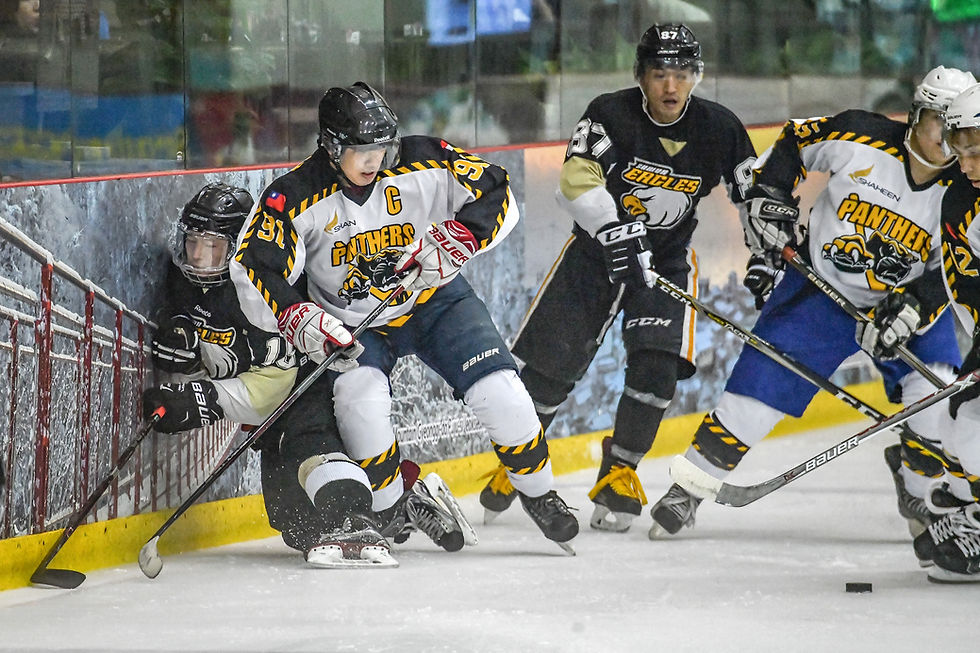Nikon D850 - 45.7MP Ice Hockey Action & Tips
- Andrew JK Tan
- Mar 9, 2018
- 3 min read
I started photographing sports from 2008 and have been hooked to this genre since the very first session.
As sports action can be extremely fast paced and peak action moments are fleeting, all sports photographers tend to use a camera that has a very fast frame capture rate. When I started , my DSLR of choice was the Nikon D3 which gave me 9FPS (Frames Per Second). This Nikon D3 however was only a 12MP (Megapixel) camera but it was a benchmark (for other DSLRs positioned for sports or fast action photography) for extreme high ISO performance.
Sports photographers do not really need ultra high MP images , we just needed images between 12MP to 20MP and it was always good enough for editorial use and editorial publications. For me though as I progressed over the years , I had always wanted higher Megapixel capability as there were many opportunities to use ultra high resolution images especially for banner / wall sized image requirements.
The other big advantage was that if I had ultra high resolution files , I potentially would have more flexibility to recompose and crop during post processing. This capability is definitely less taxing on the wallet then having to fork out for a 600mm or 800mm prime lens.
So with my new Nikon D850 which was both ultra high resolution and high speed capable up to 9FPS , I had this all-rounder of a camera that could photograph sports and really fast action. In addition to speed , the D850 had the Auto-Focus (AF) capability and extreme high ISO performance needed for low light especially in-door sports complex conditions.
Camera Setup
1. Nikon D850
2. Nikkor 80-400mm f4.5-5.6
3. Hand-Held
4. JPEG FINE * (as lighting conditions were pretty constant)
Notes
- You can click on the image to view a larger version.
- All images shared were captured from a single 3 hours session.
My TOP Tips for photographing Ice-Hockey Action
1. Tune your AF tracking performance to keep up with the very fast ice skating and physical action. For Nikon D850 users , the following were the settings that worked really well for me
- AF-C
- AF-C priority release was set to Focus+Release
- Focus Tracking Lock On options was set to level 1 and erratic
- Group AF mode
ISO8000 , 1/1000s , f5.6 , 250mm focal length
2. Use a hand-holdable zoom lens, avoid the monopod if you can.
I used my Nikkor 80-400mm f4.5-5.6 as I wanted the capability to exceed 300mm focal length for better reach. Using a hand-holdable zoom allows the photographer much more flexibility to capture the high speed action with a much higher chance of success (for both far and near action) then mounting on a monopod.
In the shot below , the physical action occurred in the middle of the rink and I needed 400mm focal length to capture it without additional cropping.
ISO8000 , 1/1000s , f5.6 , 400mm focal length
3. If the lens has a front filter , REMOVE it for better Image quality
This action becomes even more important because I had to shoot through a transparent protection panel. This is a very normal safety precaution for the sport of Ice hockey. You do NOT want to be hit by one of these ultra high speed pucks when capturing player level shots.
ISO8000 , f4.5 , 1/1000s , 85mm focal length
4. Use at least a shutter speed of 1/1000s to freeze the action if possible
ISO8000 , 1/1000s , f4.8 , 120mm focal length
5. Composition wise , I like to "sandwich" my main subject with the appropriate foreground and background like these two examples below
ISO8000 , 1/1000s , f5.6 , 350mm focal length
ISO8000 , 1/1000s , f5.3 , 240mm focal length
6. Try to capture physical action with "conflict" , avoid just capturing a single player without the opposition in the frame.
ISO8000 , 1/1000s , f5.0 , 175mm focal length
7. Go for Player Level shots , the player's faces are important and also always remember to include the puck in the composition
ISO8000 , 1/1000s , f5.6 , 250mm focal length
Well I hope you had fun reading this blog. Till the next one , enjoy your photography.
Cheers,
Andrew







